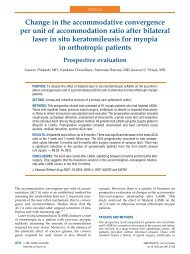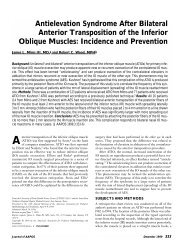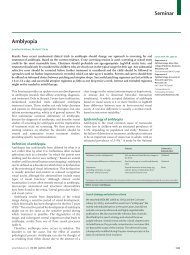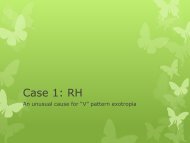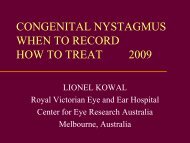What's new AAPOS 2008 - The Private Eye Clinic
What's new AAPOS 2008 - The Private Eye Clinic
What's new AAPOS 2008 - The Private Eye Clinic
You also want an ePaper? Increase the reach of your titles
YUMPU automatically turns print PDFs into web optimized ePapers that Google loves.
METHODS: One hundred and thirteen children (mean age, 5.1 years) with previously<br />
untreated bilateral refractive amblyopia were enrolled at 27 community- and universitybased<br />
sites and were provided with optimal spectacle correction. Bilateral refractive<br />
amblyopia was defined as 20/40 to 20/400 best-corrected binocular visual acuity in the<br />
presence of 4.00 diopters (D) or more of hypermetropia by spherical equivalent, 2.00 D<br />
or more of astigmatism, or both in each eye. Best-corrected binocular and monocular<br />
visual acuities were measured at baseline and at five, 13, 26, and 52 weeks. <strong>The</strong><br />
primary study outcome was binocular acuity at one year.<br />
RESULTS: Mean binocular visual acuity improved from 0.50 logarithm of the minimum<br />
angle of resolution (logMAR) units (20/63) at baseline to 0.11 logMAR units (20/25) at<br />
one year (mean improvement, 3.9 lines; 95% confidence interval [CI], 3.5 to 4.2). Mean<br />
improvement at one year for the 84 children with baseline binocular acuity of 20/40 to<br />
20/80 was 3.4 lines (95% CI, 3.2 to 3.7) and for the 16 children with baseline binocular<br />
acuity of 20/100 to 20/320 was 6.3 lines (95% CI, 5.1 to 7.5). <strong>The</strong> cumulative probability<br />
of binocular visual acuity of 20/25 or better was 21% at five weeks, 46% at 13 weeks,<br />
59% at 26 weeks, and 74% at 52 weeks.<br />
CONCLUSIONS: Treatment of bilateral refractive amblyopia with spectacle correction<br />
improves binocular visual acuity in children three to less than 10 years of age, with most<br />
improving to 20/25 or better within one year.<br />
Unilateral lens extraction for high anisometropic myopia in children and<br />
adolescents.<br />
Ali A., Packwood E., et al. .<br />
J <strong>AAPOS</strong> 2007; 11: 153-158.<br />
<strong>The</strong> authors examined a subpopulation of children with it eye anisometropic myopia,<br />
amblyopia, and neuro behavioral disorders who were ill-suited or noncompliant with<br />
spectacle and contact lens wear. Seven children from four to 20 years of age with a<br />
mean of 9.1 years had myopia from -11.92 -24.5 D (mean 16.7 D). Five eyes<br />
appendectomy in two eyes lobectomy with IOL implantation. <strong>The</strong> average myopic<br />
correction with 17.3 D.. <strong>The</strong> mean visual acuity was 20/2550 two a mean of 20/130. A<br />
mean follow-up has been 3.8 years during which time 2 eyes have had Yag-laser<br />
membranectomy and no retinal detachments have occurred. Further study is<br />
recommended by the authors to determine the long-term safety of this procedure.<br />
Stability of visual acuity improvement following discontinuation of amplyopia<br />
treatment in children aged 7 to 12 years.<br />
Pediatric <strong>Eye</strong> Disease Investigator Group<br />
Arch Ophthalmol 2007;125:655-659<br />
At the completion of a PEDIG randomized trial during which amblyopia treated with<br />
patching and atropine improved by at least 2 lines of visual acuity. Eighty patients aged<br />
7 to 12 years were followed up while not receiving treatment (other than spectacle wear)<br />
for one year. <strong>The</strong> cumulative probability of worsening visual acuity (≥2 lines) was 7%<br />
51



